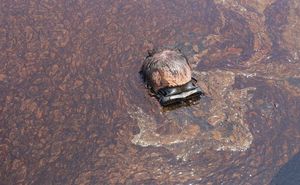It looks like you're using an Ad Blocker.
Please white-list or disable AboveTopSecret.com in your ad-blocking tool.
Thank you.
Some features of ATS will be disabled while you continue to use an ad-blocker.
4
share:
The oil that spewed into the Gulf of Mexico during the Deepwater Horizon disaster three years ago killed off millions of amoeba-like creatures that form the basis of the gulf's aquatic food chain, according to scientists at the University of South Florida.
The die-off of tiny foraminifera stretched through the mile-deep DeSoto Canyon and beyond, following the path of an underwater plume of oil that snaked out from the wellhead, said David Hollander, a chemical oceanographer with USF.
"Everywhere the plume went, the die-off went," Hollander said.
The discovery by USF scientists marks yet another sign that damage from the disaster is still being revealed as its third anniversary looms. Although initially some pundits said the spill wasn't as bad as everyone feared, further scientific research has found that corals in the gulf died.
Anglers hauled in fish with tattered fins and strange lesions. And dolphins continue dying. The full implications of the die-off are yet to be seen.
The foraminifera are consumed by clams and other creatures, who then provide food for the next step in the food chain, including the types of fish found with lesions. Because of the size of the spill, the way it was handled and the lack of baseline science in the gulf, there's little previous research to predict long-term effects. T
he disaster began with a fiery explosion aboard an offshore drilling rig on April 20, 2010. It held the nation spellbound for months as BP struggled to stop the oil, but the spill has largely faded from national headlines. The oil is still there, though. Weathered particles of oil from Deepwater Horizon are buried in the sediment in the gulf bottom and could be there for as much as a century.
USF researchers dug up core samples from the gulf bottom in 2010, 2011 and 2012, and they plan to return this year and next to compare what they found. Their examination uncovered the massive die-off, according to researcher Patrick Schwing. They also noted an absence of microscopic worms that are normally seen in those areas. The researchers could not estimate how many square miles the die-off covered.
In the core samples, they could see that most of the grayish sediment on the bottom built up gradually over centuries, said Isabel Romero, a researcher working with Hollander. But on top they found a large, dark clump of sediment from the time of the 2010 disaster.
The amount registered as 300 times the normal amount of oil-based particles found on the bottom. The oil in the sediment samples definitely came from the 2010 disaster, Hollander said. The substance bears the same chemical signature as Deepwater Horizon oil.

Source
reply to post by sarahlm
Is anyone surprised? Have you seen the news that the obozo wants to make the gulf of mexico into a gigantic "algae farm" to trade on the "carbon trades".
Where is all of this crap going to end?
Oil spews up naturally in all of the oceans - Corexit doesn't. Halliburton.
Is anyone surprised? Have you seen the news that the obozo wants to make the gulf of mexico into a gigantic "algae farm" to trade on the "carbon trades".
Where is all of this crap going to end?
Oil spews up naturally in all of the oceans - Corexit doesn't. Halliburton.
edit on 10-4-2013 by Happy1 because: (no reason given)
It’s so painful to read about all this, to watch the dying.
To think we all’ve been given such an incredible beautiful place to call our own, to live and yet we allow greed and disrespect to kill it.
Once again I’m surprised at how long I stuck with my belief man really deserves to exist at all.
peace
To think we all’ve been given such an incredible beautiful place to call our own, to live and yet we allow greed and disrespect to kill it.
Once again I’m surprised at how long I stuck with my belief man really deserves to exist at all.
peace
edit on 10-4-2013 by silo13 because: (no reason given)
new topics
-
Pentagon UFO Hunter Reveals What He Knows About Aliens: Nothing
Aliens and UFOs: 13 minutes ago -
President Bidens Health is Declining Faster 5.8.2024 - He Should Stay Home.
2024 Elections: 1 hours ago -
Court of Appeals Agrees to Hear Trump Appeal to Flush Fani Willis
US Political Madness: 1 hours ago -
I "lost" a manuscript.
Rant: 4 hours ago -
Crocodile Reported in Water near a Buckinghamshire village in the UK
Pets: 4 hours ago -
Chris Cuomo, who pushed vaccine shots on CNN, admits Moderna vaccine destroyed his health
Mainstream News: 7 hours ago -
History Shows; Many Crisis Are Artificial I'm Order To Enslave People
Political Conspiracies: 7 hours ago
4
